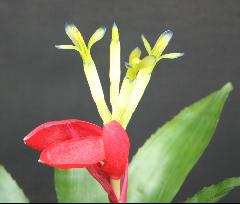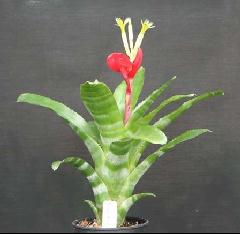



UPDATE - Detective Derek Notes. 12/12
Billbergia Collevi, A. Van Geert, Cat. no. 81, p91 in Belgique horticole 32: 334. 1882
(thanks to Eric Gouda, translated by Butcher)
Posture slender, leaves gracefully reflexed, of a beautiful green, large areas of white, flowers blue, bracts rose carmine.
Note: Hybrid between B. amoena (fem) and B. leopoldi (male) similar to that of B. Joliboisi and B. Rhedonensis.
B. x Joliboisi, A. Van Geert, Cat. No. 81, p.31
Posture stocky, leaves dark green, dusted with fine powder, marked with alternate areas of crimson-violet and bands of white, spines black, flowers blue, bracts carmine.
B. x Rhedonensis, A. Van Geert, Cat.No. 81, p. 92
Posture slender, leaves clear green with strong dusting of fine powder, narrow areas of white, spines short, Flowers blue, bracts clear carmine.
Extra information as at Dec 2012
This is prompted by the photos we now have of this hybrid as grown by Don Beadle in Florida, USA.
If we refer to Mez 1935 page 200 we see the following where the flowers for each would look very similar:
Billbergia vittata x pallescens (note that the pollen parent is now treated as B.amoena) = B. Breauteana Andre in Rev. Hortic. LVI (1884) 117.
B. vittata x amoena = B. Wittmackiana Witte in Gartenfl. XL. (1891) 328 et XLIII.(1894) 393, t. 1405.
= B. Cappei Morr. ex Bak. Bromel. (1889) 83.
= B. zebrina Cappeana Carr. in Rev. Hortic. L. (1878) 116 (false e B. Leopoldi orta ibi dicta).
= B. Joliboisii Van Geert ex Belg. Hortic. XXXII. (1882) 334 (false e B. Leopoldi orta dicta).
= B. Collevii Van Geert, l.c.
= B. rhedonensis Van Geert, l.c.
= B. Oberthueri Van Geert, l. c.
= B. Herbaulti Hort. ex Bak. Bromel. (1889) 83.
From this we can see that Mez was of the opinion that the B. leopoldii was in fact B. vittata which brings us to a plant that should flower like B. ‘Breauteana’ (Or the Australian ‘Chas Webb’) with its blue petals and yet the Australian B. collevii has petals like a B. amoena – pale green with blue tips.
The Australia plant is close to B. amoena in the shape of the inflorescence and petal colour whereas the plant that Don Beadle grew in Florida had petals like B. amoena but an inflorescence with influences of B. vittata.
The next question to ask is how did B. ‘Collevii’ get to the USA. Very few European hybrids were mentioned by either Nehrling or Mead when they were at their peak in the 1920’s to 1930’s, with species being grown. The only known hybrid was B. ‘Bruantii’ which had been obtained from the New York Botanic Garden. Mead was the very keen hybridist and in fact crossed B. pallescens (now B. amoena) with B. leopoldii. And would have called it B. pal-leo in Mead’s own shorthand. Mead died in 1936. In the 1940’s we know that Mulford Foster had Mead’s stud-book and there is a possibility that Foster could have worked out that this was the ‘old’ B. Collevii. and named it accordingly. Whereas Julian Nally who had many of the plants, may not have been aware of this change. Isn’t it a pity we do not have an inventory of the plants that Julian Nally started off with.
It does not surprise me that anyone growing seed from B. Collevii would have assumed that the seedlings were also B. Collevii. BUT we know that B. ‘Collevii’ is a primary hybrid and you get a mixed bag from the next generation with some looking like B. amoena and some like B. vittata and some in between. I would suspect that Mead’s original crossing has died out in the course of time – but who knows?
I cannot see any advantage in trying to get the owners of B. ‘Collevii’ to change their labels to a new name, so the imposter stays. The keen ones will note the situation by reading the detail on the BCR.